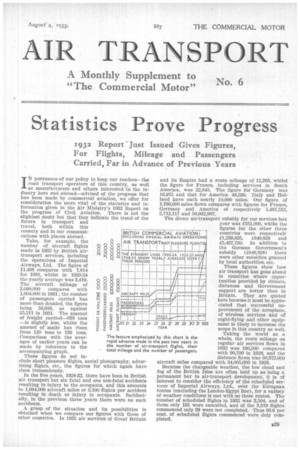Statistics Prove Progress
Page 39

If you've noticed an error in this article please click here to report it so we can fix it.
1932 11! eport" just Issued Gives Figures, For Flights, Mileage and Passengers Carried, Far in Advance of Previous Years
IN pursuance of our policy to keep our readers—the road transport operators of this country, as well as manufacturers and others interested in the industry here and abroad—advised of the progress that has been made by commercial aviation, we offer for consideration the more vital of the statistics and information given in the Air Ministry's 1932 Report on the progress of Civil Aviation. There is not the slightest doubt but that they indicate the trend of the future in transport and travel, both within this country and in our communications with places abroad.
Take, for example, the number of aircraft flights made in 1932 by British airtransport services, including the operations of Imperial Airways, Ltd. The figure of 11,468 compares with 7,814 for 1931, whilst in 1920-24 the yearly average was 3,419. The aircraft mileage of 2,090,000 compares with 1,604,000 in 1931; the number of passengers carried has more than doubled, the figure being 56,683, as against 25,211 in 1931. The amount of freight carried-638 tons —is slightly less, whilst the amount of mails has risen from 120 tons to 139 tons. Comparison with the averages of earlier years can be made by reference to the accompanying graph.
These figures do not include short pleasure flights, aerial photography, advertising flights, etc., the figures for which again have risen tremendously.
In the five years, 1928-32, there have been in British air transport but six fatal and one non-fatal accidents resulting in injury to the occupants, and this amounts to 1,094,000 aircraft miles or 5,700 flights per accident resulting in death or injury to occupants. Incidentally, in the previous three years there were no such accidents.
A grasp of the situation and its possibilities is obtained when we compare our figures with those of other countries. In 1932 air services of Great Britain
rs.1
0 8
tr,
ls1
FREIGHT OR MAIL (TOO 1000 PASSENGERS CAR RIED AIRCRAFT MILES
8 8
BRITISH INctuoiNG
I Li!
THE ST A1GHT 1928-32 SHOW PERIOD
•
AIRCRAFT
•
MILES 11111111—
rhEi
I
FREIG1:1T-7-1 r
and its Empire had a route mileage of 11,263, whilst the figure for France, including services in South America, was 22,845. The figure for Germany was 16,975 and that for America 48,530. Italy and Holland have each nearly 10,000 miles. Our figure of 1,766,000 miles flown compares with figures for France, Germany and America of respectively 5,487,512, 5,712,117 and 50,932,967.
The direct air-transport subsidy for our services last year was £551,000, whilst the figures for the other three countries were respectively £1,239,835, £849,828 and £5,437,730. In addition to the German Government's subsidy (£849,8281 there were other subsidies granted by local authorities, etc. &DMMERCIAL
I I AIRWAYS
AVIATION
OPERATIONS) PLEASURE FLIGHTS) 1 1 1
I
YEARLY 1920
diTHESE
AVERAGES 24,
I 925-27
AND, OVER
i These figures show how air transport has gone ahead in countries where opportunities provided by climate, distances and Government support are better than in Britain. They are quoted here because it must be appredated that successful improvement of the aeroplane, of wireless services and of night-flying and other equip
1932 ment is likely to increase the scope in this country as welL Taking the world as a whole, the route mileage on regular air services flown in 1932 was 190,200 compared with 90,700 in 1928, and the distance flown '13.;as 90,372,000 aircraft miles compared with 34,005,000 in 1928.
Because the changeable weather, the low cloud and fog of the British Isles are often held up as being a permanent bar to air-transport development, it is of interest to consider the efficiency of the scheduled services of Imperial Airways, Ltd., over the European routes (excluding the London-Egypt line), for a variety of weather conditions is met with on these routes. The number of scheduled flights in 1932 was 3,504, and of these only 185 were cancelled, and of the 3,319 flights commenced only 39 were not completed. Thus 93.6 per cent. of scheduled flights commenced were duly completed.
23 24 23 26 28 29 30 31
YEAR




















































































